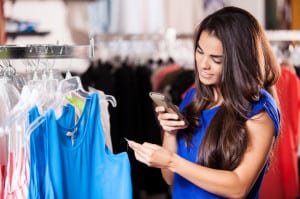 Through the ubiquity of mobile devices, retailers have an opportunity to arm their customers and employees with mobile applications that deliver unprecedented levels of customer loyalty, engagement, and service.
Through the ubiquity of mobile devices, retailers have an opportunity to arm their customers and employees with mobile applications that deliver unprecedented levels of customer loyalty, engagement, and service.
Many retailers have developed mobile shopping apps, which are providing added value to consumers, from letting them easily conduct initial product research to enabling them to make a purchase from wherever they may be. The best of these apps also include software-based mobile barcode scanning and data capture capabilities with a variety of benefits: quick and easy access to product information at home or in-store, shopping list creation, self-scanning and self-checkout in stores, to name just a few.
With the introduction of highly reliable software-based scanning on smartphones, devices, and wearables, the mobile retail landscape expands beyond consumer shopping apps to innovative applications for employees.
For example, sales associates can quickly and easily access consultative (or “clienteling”) apps on their own or retailer-provided smartphones allowing them to deliver higher levels of customer service, and outdated check-out stations can be replaced with smaller, more flexible mobile point-of-sale systems.
Let’s take a look at some examples of how mobile barcode scanning can help make consumers’ lives easier while increasing retailers’ bottom lines:
Empowering Consumers:
Coupons and Rewards Programs
Retailers can offer mobile shopping apps that let consumers scan barcodes of certain products in-store and receive coupons, discounts and points towards loyalty rewards programs.
Shopkick is a great example of this type of app. It not only makes shopping convenient and cost-effective for consumers but also fun and engaging, through a gamified shopping environment. For retailers that offer deals and “kicks” or incentives through the app, it drives more foot-traffic to the store and increased customer engagement, which leads to increased loyalty and sales.
Self-Scanning and Self-Checkout
Consumers who use their mobile devices to scan products as they shop enjoy a highly personalized shopping experience. They can then efficiently check out on their own through self-checkout, using their devices, rather than having to wait in line or waste time removing and replacing items in their cart that could have been scanned immediately upon removal from the shelf.
In addition, rather than allocating valuable aisle real estate to multiple self-checkout kiosks, retailers only need to have a single self-checkout station that totals the self-scanned items or support an app with mobile payments built in.
They can also reduce labor costs for check-out or re-deploy staff to provide increased levels of customer service. Most significantly, once a consumer has downloaded and installed a self-scanning/checkout app, the retailer benefits from a realtime, two-way communication channel with that customer, which opens up many powerful marketing and engagement possibilities.
Scanning at Home or On the Go
Consumers face the constant challenge of managing their time and shopping in an efficient and effective manner. Retailers can offer print advertisements and marketing materials with barcodes, enabling consumers to scan them from any location to make shopping lists, access coupons and deals, and/or purchase products directly from their mobile device.
For example, Ex Libris, the largest online retailer for books, CDs, and games in Switzerland, is including barcodes in its circulars and on large ads in the streets next to advertised products, enabling consumers to scan and instantly purchase the products from their mobile device wherever they see the ads.
Mobile Applications for Retailers
Clienteling
Envision a shopping experience where every associate on the retail floor knows everything there is to know about the products you are browsing. Want that shirt in a different color? No problem: the sales associate simply scans the barcode on the box and instantly accesses the options available in the storeroom without wasting time, or losing the sale.
Real-world shopping cart abandonment happens every day and can cost retailers millions of dollars. Intelligent clienteling apps incorporate associate self-scanning from any smartphone or tablet, allowing associates to deliver increased levels of customer service. Retailers can further benefit by offering this higher level of consultative service through the bring-your-own-device (BYOD) model, without additional investment in dedicated devices.
Mobile Point of Sale (mPOS)
Dedicated, traditional hardware-based point-of-sale systems are costly and take up valuable real estate for merchants. For smaller businesses and larger enterprises who want a more innovative and visually appealing solution, software-based, enterprise-grade barcode scanning technology, as part of a smartphone or tablet-based mobile point-of-sale system, can dramatically lower costs and maximize limited human resources. Empowering employees with a familiar and easy-to-use app-based scanner also helps reduce checkout times and gives retailers a competitive edge in the market.
Mobile barcode scanning opens up a world of options for retailers looking to more deeply engage their customers, improve efficiencies, or deliver a higher level of customer service. Whether you are interested in creating a mobile shopping app for your customers, a clienteling app for your associates, or transforming your point-of-sale systems, be sure to incorporate a rock-solid, enterprise-grade solution your employees and your customers will love. It’s a win-win for both parties.
Samuel Mueller is co-founder and CEO of Scandit.